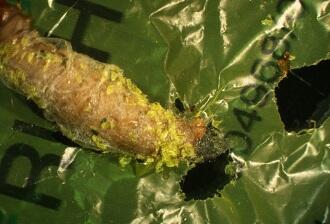The caterpillar that digests polyethylene

Galleria Mellonella probably says little to most people; larva of the greater wax moth can perhaps give a hint of what it is; caterpillar is understandable to all. This caterpillar, however has a very special ability, accidentally discovered by an Italian biologist: it digests polyethylene.
After having placed some great wax moth larvae from a beehive on a plastic bag, the biologist and beekeeper Federica Bartocchini (pictured below), of the Spanish National Research Council (Csic), realized that it was full of holes and that only the larvae could have made them. Along with Paolo Bombelli and Christopher Howe, of the Cambridge University Department of Biochemistry, she therefore planned an experiment to test whether her deduction was correct.
One hundred larvae were laid on a plastic bag. Just over half an hour the first holes began to appear and after about 12 hours the mass of the envelope had shrunk by 92 milligrams. This level of degradation was judged significant and extremely rapid by the researchers compared to that, for example, of certain bacteria which in one day are able to degrade approximately 0.13 milligrams of PET.
This is
possible because the larvae feed on bee wax, a rich complex of various
molecules that are kept together by a bond similar to the one that supports the
strong molecular structure of polyethylene: a repeating chain of carbon atoms.
The degradation of plastics, whose precise metabolism will be the subject of a
further study, also does not happen only as a result of a mechanical action -
the chewing by the caterpillars - but also of a chemical process.



















